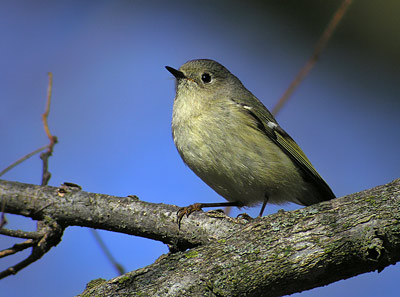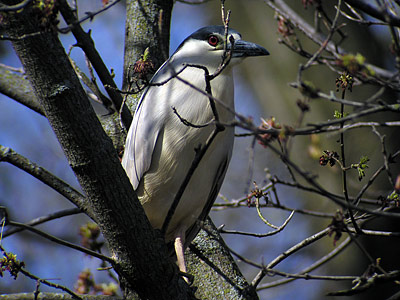
Of all the songbirds I've ever digiscoped, I think kinglets rank among the most difficult. They're hardly ever still for more than 1/10th of a second. The only way I've ever successfully digiscoped them has been through the practice of trying to anticipate what perch they're going to fly to next. Well, most of the time it doesn't work, but occasionally I get lucky, as I did yesterday with this Ruby-crowned Kinglet.

On the other hand, Yellow-rumped Warblers may be one of the easiest warblers to photograph because they frequently pause on a perch between sorties. Though serious business for the warbler, it's quite entertaining watching them grab several flying insects from a swarm in a single pass.

Yesterday's biggest surprise was finding this Black-crowned Night Heron just before the entrance to the retention ponds. I've only ever seen this species one other time before at Pheasant Branch Conservancy.
Location: Pheasant Branch
Observation date: 4/22/09
Number of species: 37
Mallard
Black-crowned Night-Heron
Broad-winged Hawk
Killdeer
Ring-billed Gull
Mourning Dove
Belted Kingfisher
Red-bellied Woodpecker
Downy Woodpecker
Hairy Woodpecker
Northern Flicker
Eastern Phoebe
Blue Jay
American Crow
Tree Swallow
Black-capped Chickadee
White-breasted Nuthatch
Golden-crowned Kinglet
Ruby-crowned Kinglet
Blue-gray Gnatcatcher
Hermit Thrush
American Robin
European Starling
Yellow-rumped Warbler
Eastern Towhee
Chipping Sparrow
Field Sparrow
Song Sparrow
Swamp Sparrow
Northern Cardinal
Red-winged Blackbird
Eastern Meadowlark
Brown-headed Cowbird
House Finch
Pine Siskin
American Goldfinch
House Sparrow
Southerly winds tonight – tomorrow should bring great things!
© 2009 Mike McDowell

















